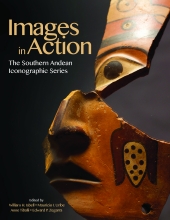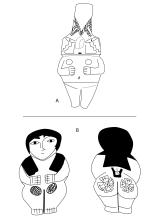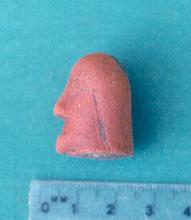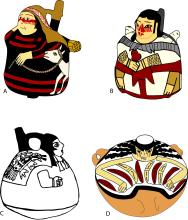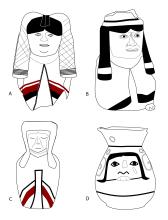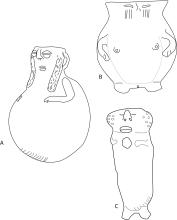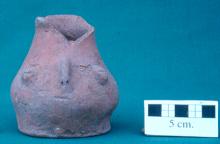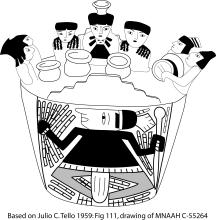Visual database
Inca votive figurines like the one illustrated here have been found in a variety of offering contexts, including high mountain capacocha human sacrifices and offerings submerged in Lake Titicaca near the Islands of the Sun and Moon. This example was executed in gold, but others have been found made of both silver and Spondylus shell. Drawn from photo of item on display at Museo Contisuyu, Moquegua, Peru.
Paracas and Nasca figurines like these were created as nudes with minimal surface decoration. Like Inca votives, such figurines may have been intended to be used clothed in small textiles, rather than nude. Both figurines are solid, unlike effigy vessels, which are hollow. (a) Unslipped Paracas Cavernas figurine with incised decoration on the face and emphasizing the pubic area and vaginal slit. Small breasts are applied to the chest (drawn from photo of American Museum of Natural History accession 641.0/8484). (b) Two views of a slipped Nasca 4 figurine, redrawn from Proulx (2006).
Wari female figurine or effigy. This example lacks the well-modeled attributes evident in some figurines and is not depicted as nude. Instead, she has a carefully painted dress with white underskirt and a decorated hem, belt, and collar held in place by a set of three tupu pins. Similar to many Nasca and Paracas figurines, her face is decorated with "tear marks," in this case executed in red slip. Like most votive figurines, her arms are placidly placed across the chest/abdomen. Drawn from photo (Young-Sanchez 2004:153, Figure 6.1, colors approximate, specimen represents American Museum of Natural History, New York 41.2/8596).
Photo of head of small ceramic figurine from the site of Iwawi, Bolivia. The fragment dates to the Tiwanaku period and was found in domestic contexts. Like female figurines from other contexts, it has long, center-parted hair; traces of black slip/paint still remain. A possibly unique Tiwanaku trait may be the strongly emphasized chin, which here protrudes past the nose. Original photo courtesy of the Iwawi Archaeological Project.
Nasca vase with bands of female, "Betty Boop" faces. The female face motif is accompanied by chevrons in alternating bands of red, gray, brown, cream, and yellow; a band of stylized triangular faces; and a band of more abstract icons, possibly stylized trophy heads. From the collections of the Milwaukee Public Museum, author photo.
Late Nasca face-neck jars depicting females, most in active poses. (a) A woman in a dark dress carries a bundle of wood suspended from a tumpline across her forehead and leading a white camelid, perhaps to a sacrificial offering (drawn from photo by Proulx 2006:Plate 36, colors approximate); (b) a woman in a white dress, red facial decoration, and fish-scale markings on her arms rests with legs flexed while carrying two anthropomorphic figures (babies?) on her back (drawn from photo by Proulx 2006, colors approximate); (c) this example is less active than the others illustrated but wears a mantle with an elaborate depiction of a mythical creature (adapted and redrawn from Proulx 2004); (d) this example displays strings of peppers or legume pods perhaps in the act of making an offering (drawn from photo of Arthur M. Sackler collection accession N339, published by Katz 2004, colors approximate).
Tiwanaku effigy jars show females in seated or kneeling poses in which hands and feet are often only implied by the modeled form. (a) This is one of several jar fragments from Pariti found as part of a buried cache of ceramics, many of which represented females clothed in striped mantles and wearing a lobed headdress or elaborate hairdo. A small raised bump of clay on the right cheek, near the nose, may represent a mole, suggesting that the vessel is a portrait of an actual person, not merely an idealized image. Drawn from photo by A. Korpisaari (Korpisaari and Parssinen 2005:Photo 4); (b) this vessel from Cochabamba depicts a sitting or kneeling female with one knee raised. Like the Pariti figure, her mantle has a dark stripe at the hem and her hair is held in place by two large strips at the bottom of the braids. Drawn from black and white photo (Eisleb and Strelow 1980:Plate 258); (c) another vessel from the Cochabamba region depicting a female figure in a striped mantle and perhaps a headdress. Drawn from black and white photo (Eisleb and Strelow 1980:Plate 259); (d) a vasija vessel form with a painted and modeled female face as the main element of decoration. Like other females, her hair is parted to either side and she may have "tear marks" on her cheeks. Like many effigies, the nose is modeled, but in a uniquely Tiwanaku twist, the chin is also modeled to give it prominence.
Unslipped vessels can sometime be recognized as female. a) A globular vessel from Chen Chen sports long braids falling over her shoulders, like other Tiwanaku effigies, such as in Figure 24 above. The eyes and mouth are appliqués shaped like "coffee beans". Drawn from photo (Owen and Goldstein 2002); b) a globular vessel in the La Ramada style clearly displays female sex characteristics - breasts and a vaginal slit. Incised lines under the eyes may represent "tear marks" like those often seen in depictions of Nasca females, see Figure 23 for examples; c) other vessels in the La Ramada style are more ambiguous and lack clear markings of female gender or sex. The projections at the side of the face could be abstract renderings of braids and the aperture in the chest a misplaced vaginal opening, but it is difficult to say without contextual information, which this piece sadly lacks.
An unslipped jar with "coffee bean" eyes from the Tiwanaku site of Iwawi. The eyes, nose, and mouth depicted on the side of this vessel are clearly anthropomorphic and reminiscent of ones from Moquegua and Arequipa shown in Figure 20.25. It is difficult to identify the face as female, however. If vessel shape is significant, then it is important to note that this vessel is similar to the one with a more obvious female face illustrated in Figure 20.24d.
Rooftop scene with three female figures prominently placed in the center of the ensemble. The female figures are flanked by four male figures, two on each side, each wearing a different type of head covering; one plays a drum. The scene may represent a feast or ceremony in which chicha is being served from several large jars. The largest of the figures is the central female; she wears a prominent collar or pendant and appears to be presiding over the activity flanked by her two female companions. The males appear only as auxiliary figures. Vessel is from Museo Nacional de Antropología, Arqueología, y Historia de Perú, registry C-55264, after Proulx (2006:Figure 5.118) and Tello (1959:Figure 111).
